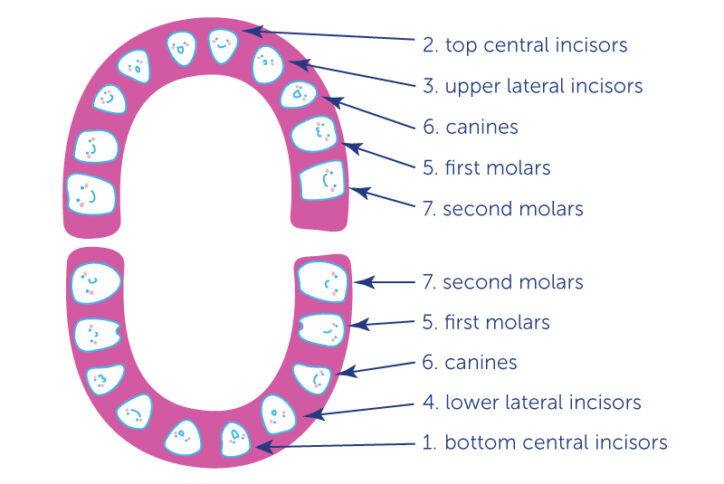Tips for teething: How to enjoy your child’s big moment

The emergence of a baby’s primary teeth (their baby teeth) is a joyful milestone for parents but it can also be an uncomfortable time for the infant. Their gums can swell and feel tender, possibly making them feel irritable and causing them to lose sleep.
We asked Dr. Grace Anderson from Boston Children’s Department of Dentistry for advice on what you should expect and how you can help your child when they start cutting teeth.
When will my infant get their first tooth?
Most babies start teething between 6 and 9 months. The two teeth that usually arrive first are the bottom central incisors. Those are the teeth you clearly see on the bottom, in the front part of the mouth. Sometimes, primary teeth appear later than 9 months. Very rarely, some babies are born with a few teeth already in place.
What are signs the first tooth is about to arrive?
About a month before a tooth arrives, you will see the lower gum protruding. That’s the root growing underneath and the tooth being pushed up.
You will eventually see the top edge of the tooth peek out. After a few more days or weeks, pop! A little tooth has completely surfaced.
Another sign that your baby is teething is they might drool quite a bit. It’s unclear whether that’s because infants produce more saliva when teething or because they’re putting their fingers in their mouths and feeling things. Another sign of teething is fussiness.
Also, some parents find that their infant has a low-grade fever. Studies haven’t found an association between a true fever and teething. That doesn’t mean a child’s temperature can’t be slightly elevated.
In what order do baby teeth come in?
The typical order is from the front to the back of the mouth with canines coming in later. The first to arrive are the bottom central incisors and the last to come in are the top and bottom second molars.

How can I make my child feel comfortable?
Some babies are resilient. Their teeth come through with no visible signs of discomfort. But others may need relief. Fortunately, there are a number of ways to help your infant manage pain and discomfort.
Refrigerated teething rings are safe and comforting. You can also put a cold piece of fruit like a strawberry or grape into a mesh pouch that’s designed for teething babies. If their gums are sore, they might not like to bite on food on its own, but the fruit inside the mesh can feel nice — and it’s safe. Also consider soaking a washcloth with formula or breast milk and placing it in the fridge for a bit. The cold of the cloth will diminish gum soreness, and your child will like tasting the milk.
Is there anything I should not give them?
We do not recommend using an over-the-counter topical numbing gel or liquid on their gums. Those products contain an anesthetic ingredient, benzocaine, that the U.S. Food and Drug Administration says can lead to a rare but serious blood-oxygen disorder called methemoglobinemia. Once your child is older than 1 and has teething discomfort, you can give them a small dose of Infants’ Motrin. We don’t recommend this for children younger than 1.
Should I change my child’s diet when they’re teething?
No, they can continue eating the foods that are already part of their diet. After a tooth has arrived, sensitivity should diminish, so having something to bite will feel good.
When should I start brushing their teeth?
Start brushing as soon as that first tooth arrives. Squirt a small bit of fluoride toothpaste — the size of a grain of rice — on a soft-bristled toothbrush made for infants. Swoosh the toothpaste around the bristles to prevent your child from accidentally swallowing it. Babies can get cavities, so brushing as early as possible is key to good dental health. And remember to bring your child for their first dentist visit by age 1! This will start them on a path to good dental hygiene. And if your child injures a tooth, you will have that dentist on speed dial.
What should I do if my child injures or loses a primary tooth?
Sometimes, kids fall and bump their front teeth. Most of the time, trauma is minor, and they heal pretty well. If your child injures a baby tooth, there might be a lot of blood, and their lip might get puffy if it also was injured. Your child’s dentist can monitor the tooth for any change of color and the mouth for swelling.
If a tooth is chipped, the dentist will also monitor it but usually no treatment is necessary unless the chip is large. If a baby tooth is knocked out, we don’t recommend putting it back in. Baby teeth eventually fall out.
Learn more about Boston Children’s Department of Dentistry or make an appointment.
Related Posts :
-

Kids and gum disease: Top six things parents should know
Every kid needs a healthy smile — and strong teeth are just part of the equation. While a cavity affects only ...
-

Cavities are no trick: How to balance Halloween candy with healthy teeth
Believe it or not, dentists don’t dislike Halloween. They don’t secretly wish for kids to not eat candy. ...
-

Amanda gets the smile she always wanted — just in time for college
One of the first things you’ll notice about Amanda Altemus is her big smile. She’s a proud Clemson ...
-

Save that shot and your child’s teeth: The benefits of mouthguards
Competitive sports can get intense. They can also get physical, with athletes inadvertently colliding and balls moving fast at all ...





